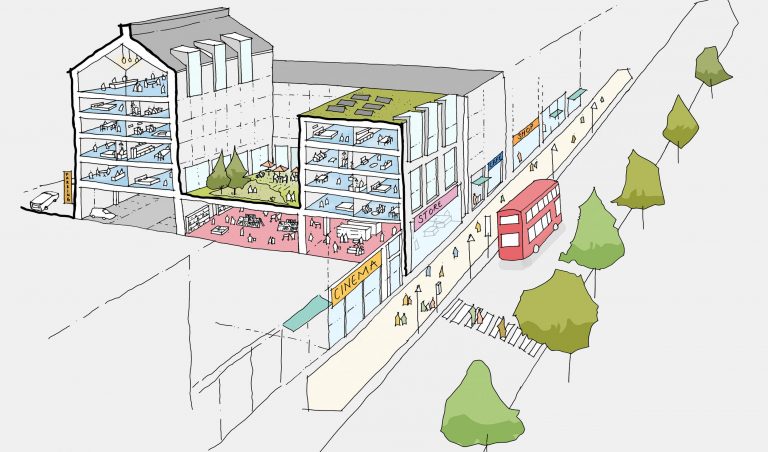What’s the right direction for the high street?
Clear government policy is needed to support efforts to revive flagging town centres, says Pete Ladhams in Housing Today.
The high street is in trouble. Recently, Arcadia clawed its way back from the brink as Philip Green’s rescue plan was narrowly approved by his creditors via a company voluntary arrangement (CVA). The likelihood of a full recovery, however, is slim, with only 15% of companies entering CVAs surviving. Arcadia’s decline is symptomatic of the upheaval going on in British high streets, and without decided change, plenty more retailers will follow suit.
Reimagining the high street is vital for preventing our towns and urban centres from becoming empty areas that act only as reminders of times gone by, when the traditional high street was a hub of community and enterprise. The need to reinvent the high street shouldn’t just be driven by an urge to reverse the decline of retail outlets. It should be about ensuring the high street is a place where people want to spend time, experience and live – orientated around wellbeing and high-quality, complementary housing.

And it can be appealing too. Urban centres are amenity rich and can be the ideal locations for professionals looking to shorten their commutes, families wanting easier access to schools, and the elderly, whose mobility and independence is vastly improved on the high street given the infrastructure on their doorstep.
The key to bringing housing onto the high street is that it complements the existing features and social infrastructure – the transport links, parks and amenities – helping to drive footfall and create an authentic sense of place, where uses sustain and maintain one another. As the high street continues its steady decline, many people have come out in favour of a straight retail to residential conversion, delivering homes in place of shops to maximise the volume coming to market. But this would simply replace one monoculture with another, threatening the fabric of the high street and restricting its ability to improve people’s wellbeing.
But for the high street to re-orientate itself in this way, it must seek to provide an experience that entices people to leave the comfort of their homes. It needs to clean up its act, which starts with the air. Currently, air pollution contributes to 64,000 premature deaths a year in the UK. Without clear policy around decarbonisation and pedestrianisation, people will continue to abandon the high street. The economic knock-ons of pedestrianisation are simple: people spend more time out and about and are thereby more inclined to spend some cash, boosting the local economy.
The introduction of the Future High Street Fund this year promises £25m for projects per local area, but it’s a relatively small sum of money for the scale of investment needed. Yet the built environment must lead the way in demanding policy changes to help drive high street renewal. For instance, to create a vibrant high street, there needs to be more flexibility around use classes to help bring tenures together and create cohesive, vibrant hubs. This is something the government is currently mulling over, with draft legislation allowing landlords and retailers to convert ailing shops to different uses without planning permission by merging A1, A2 and A3 into a single use class. While this would speed the process of conversions up, design quality must also be prioritised, as some schemes have recently come under scrutiny for poor quality.
But for us to reignite the life and soul of the high street, we must look beyond traditional forms of residential housing. One such model that we have been exploring is the concept of a “high street living room”, where complementary residential uses sit alongside, or above, ex-retail spaces that have been converted and opened up as community hubs. The idea is to bring life back to the high street once more, and create spaces and opportunities for community bonds to be forged – a vital backbone to our wellbeing.
In terms of urban design, increasing these opportunities can be as easy as ensuring there are several benches and seating areas, but can also extend to lease types. There are plenty of such community initiatives springing up around the UK, such as Central Parade in Walthamstow, where the local authority has helped refurbish the space to create a location where members of the community can work and collaborate on businesses or social initiatives, benefitting the broader community and boosting the local economy.
These aptly labelled “meanwhile spaces” are not just being used by local authorities; many developers are beginning to utilise them to lure interesting anchor tenants as part of wider placemaking strategies, where housing and other uses are blended to create a sense of place. This same approach could equally be applied to the high street, with under-occupied spaces transformed into flexible community spaces that bring back dynamism and vibrancy, while providing interesting amenities to nearby housing.
If we want to rebuild thriving high streets that support the population’s wellbeing, provide an experience, and prioritise community and economic growth, we need clarity of policy and procedure, while prioritising community and support networks. Of course, each high street is different and there is no one-size-fits-all approach, but ambiguities from the policy environment do the built environment no favours when it comes to reviving the high street in a way that is orientated around wellbeing, community and user experience.
Published in Housing Today on 10 July 2019.